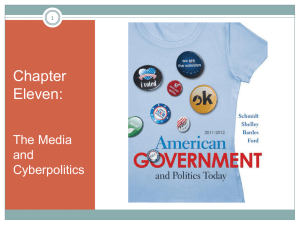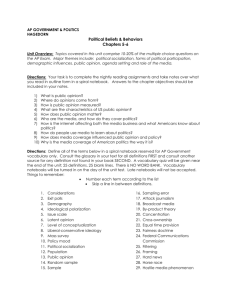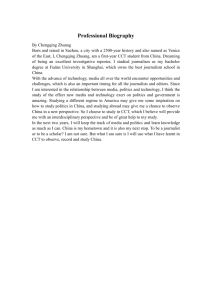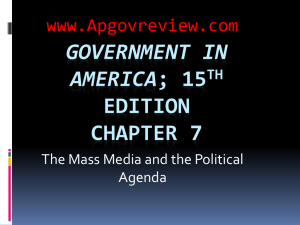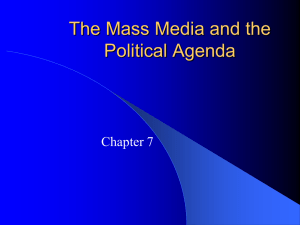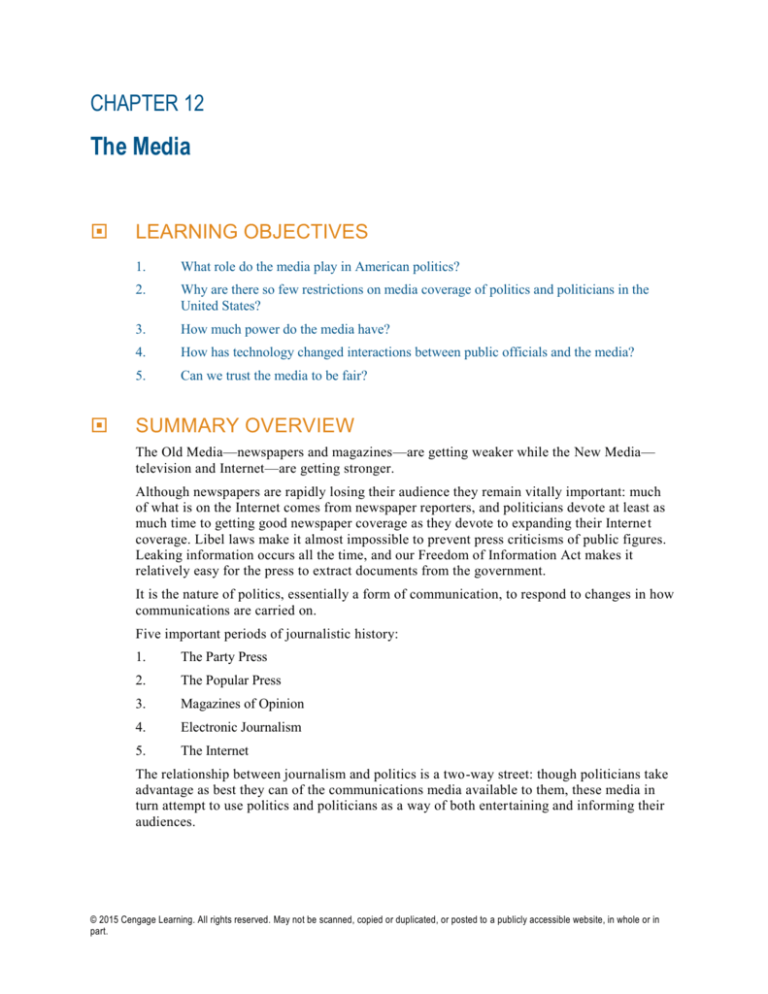
CHAPTER 12
The Media
LEARNING OBJECTIVES
1.
What role do the media play in American politics?
2.
Why are there so few restrictions on media coverage of politics and politicians in the
United States?
3.
How much power do the media have?
4.
How has technology changed interactions between public officials and the media?
5.
Can we trust the media to be fair?
SUMMARY OVERVIEW
The Old Media—newspapers and magazines—are getting weaker while the New Media—
television and Internet—are getting stronger.
Although newspapers are rapidly losing their audience they remain vitally important: much
of what is on the Internet comes from newspaper reporters, and politicians devote at least as
much time to getting good newspaper coverage as they devote to expanding their Interne t
coverage. Libel laws make it almost impossible to prevent press criticisms of public figures.
Leaking information occurs all the time, and our Freedom of Information Act makes it
relatively easy for the press to extract documents from the government.
It is the nature of politics, essentially a form of communication, to respond to changes in how
communications are carried on.
Five important periods of journalistic history:
1.
The Party Press
2.
The Popular Press
3.
Magazines of Opinion
4.
Electronic Journalism
5.
The Internet
The relationship between journalism and politics is a two-way street: though politicians take
advantage as best they can of the communications media available to them, these media in
turn attempt to use politics and politicians as a way of both entertaining and informing their
audiences.
© 2015 Cengage Learning. All rights reserved. May not be scanned, copied or duplicated, or posted to a publicly accessible website, in whole or in
part.
80
Chapter 12: The Media
The national media have three key roles:
1.
gatekeeper,
2.
scorekeeper, and
3.
watchdog.
The ways newspapers and television stations perform these roles differs significantly based
on a few different factors. A newspaper can cover more stories in greater depth than a TV
station and faces less competition from other broadcasters. This allows newspaper reporters
to have more freedom to develop stories. A TV station faces brutal competition, must select
its programs in part for their visual impact, and must keep its stories short and punchy. TV
stations have little freedom; the fear of losing their audience is keen.
The least competitive media outlets are almost entirely free from government regulation
whereas the most competitive ones must have a government license to operate and must
adhere to a variety of government regulations.
The Supreme Court has upheld the right of the government to compel reporters to divulge
information as part of a properly conducted criminal investigation, if it bears on the
commission of a crime.
Deregulation has lessened the extent to which the federal government shapes the content of
broadcasting. During campaigns, a broadcaster must provide equal access to candidates for
office. One aspect of campaigning that worries scholars is the media’s reliance on horserace journalism.
The journalistic philosophy in many media documents is that the press, when it reports the
news, should be neutral and objective. The truth of the matter is that bias tends to reflect the
political views of its readers.
There are different opportunities for bias based on the type of story:
1.
Routine stories
2.
Feature stories
3.
Insider stories
The media often falls prey to selective attention—people remember or believe only
what they want to. What the press covers also affects the policy issues that people think
are important.
American government is the leakiest in the world; White House staff regularly leak stories
favorable to their interests. We have an adversarial press, one that is suspicious of
officialdom and eager to break an embarrassing story. Journalists today are far less willing to
accept at face value the statements of elected officials and are far more likely to try to find
somebody who will leak “the real story.” We also live in an era of attack journalism, seizing
upon any bit of information or rumor that might call into question the qualifications or
character of a public official.
There are four ways that reporters and public officials, or their press officers communicate:
1.
on the record,
2.
off the record,
3.
on background, and
4.
on deep background.
© 2015 Cengage Learning. All rights reserved. May not be scanned, copied or duplicated, or posted to a publicly accessible website, in whole or in
part.
Chapter 12: The Media
81
The ultimate weapon in the government’s effort to shape the press to its liking is the
president’s rewarding of reporters and editors who treat him well and his punishing of those
who treat him badly.
CHAPTER OUTLINE
I.
The Media and Politics
II.
Journalism in American Political History
III.
IV.
V.
VI.
A.
The Party Press
B.
The Popular Press
C.
Magazines of Opinion
D.
Electronic Journalism
E.
The Internet
The Structure of the Media
A.
Degree of Competition
B.
The National Media
1.
Gatekeeper
2.
Scorekeeper
3.
Watchdog
Rules Governing the Media
A.
Confidentiality of Sources
B.
Regulating Broadcasting
C.
Campaigning
Are the National Media Biased?
A.
A Liberal Majority
B.
Neutral and Objective?
C.
Media’s Influence
Government and the News
A.
Prominence of the President
B.
Coverage of Congress
C.
Why Do We Have So Many News Leaks?
D.
Sensationalism in the Media
E.
Government Constraints on Journalists
© 2015 Cengage Learning. All rights reserved. May not be scanned, copied or duplicated, or posted to a publicly accessible website, in whole or in
part.
82
Chapter 12: The Media
TEACHING TOOLS
LEARNING OBJECTIVE 1: WHAT ROLE DO THE MEDIA PLAY IN
AMERICAN POLITICS?
Critical Thinking Question
Discuss how the media influences American politics.
In-Class Activity
Discuss how the media has expanded its influence in politics since the foundation of
our government.
Lecture Launcher
Have students discuss their perspective on the media’s influence in politics. Ask the class to think
about media bias, favoring of a party or candidate, etc.
LEARNING OBJECTIVE 2: WHY ARE THERE SO FEW RESTRICTIONS ON
MEDIA COVERAGE OF POLITICS AND POLITICIANS IN THE UNITED STATES?
Critical Thinking Question
Explain the rights of the media in its coverage of politics; include the connection of these rights to
the first amendment.
In-Class Activity
Divide the class into five groups, each group will be assigned one media outlet (newspaper,
magazine, radio, television, and the Internet); the groups will discuss/research their medium and
inform the class of its regulations over their coverage.
Lecture Launcher
Discuss whether the restrictions on the media are too lenient or too restrictive. Expand the
discussion to include how the media has expanded, and so have their rights and restrictions.
LEARNING OBJECTIVE 3: HOW MUCH POWER DO THE MEDIA HAVE?
Critical Thinking Question
Explain the three roles of the national press; tell why each role is significant to our politics.
In-Class Activity
Discuss how the government attempts to use the media. Include in this discussion how this has
expanded the role of the media in politics.
© 2015 Cengage Learning. All rights reserved. May not be scanned, copied or duplicated, or posted to a publicly accessible website, in whole or in
part.
Chapter 12: The Media
83
Lecture Launcher
Discuss the influence the media has over our understanding, interpretation, and selection of
politicians and policies.
LEARNING OBJECTIVE 4: HOW HAS TECHNOLOGY CHANGED
INTERACTIONS BETWEEN PUBLIC OFFICIALS AND THE MEDIA?
Critical Thinking Question
Explain how the government has increased its usage of media to reach citizens and constituents.
In-Class Activity
Discuss the expansion of technology usage by government officials to spread the word on
candidacy and policy.
Lecture Launcher
Ask the class to discuss the pros and cons of the usage of the media by public officials.
LEARNING OBJECTIVE 5: CAN WE TRUST THE MEDIA TO BE FAIR?
Critical Thinking Question
Choose one of the five types of media (newspaper, magazines, radio, television, and Internet) and
discuss their objectivity when reporting on politics. How fair or biased is this medium in
its reports?
In-Class Activity
Ask the class whether or not it is possible for the media to be fair—unbiased—in its reporting.
Lecture Launcher
Ask the class if they feel the regulations currently in place ensure media fairness? Should there be
stricter regulations?
KEY TERMS
adversarial press
The tendency of the national media to be suspicious of
officials and eager to reveal unflattering stories about them.
background
A public official’s statement to a reporter given on condition
that the official not be named.
blog
A series, or log, of discussion items on a page of the World
Wide Web.
equal time rule
An FCC rule that if a broadcaster sells time to one candidate,
it must sell equal time to other candidates.
© 2015 Cengage Learning. All rights reserved. May not be scanned, copied or duplicated, or posted to a publicly accessible website, in whole or in
part.
84
Chapter 12: The Media
feature stories
Media stories about events that, though public, are not
regularly covered by reporters.
horse-race journalism
News coverage that focuses on who is ahead rather than on
the issues.
insider stories
Media stories about events that are not usually made public.
loaded language
Words that imply a value judgment, used to persuade a reader
without having made a serious argument.
routine stories
Media stories about events regularly covered by reporters.
selective attention
Paying attention only to those news stories with which one
already agrees.
sound bite
A radio or video clip of someone speaking.
trial balloon
Information leaked to the media to test public reaction to a
possible policy.
WEB LINKS
To search many news sources: www.ipl.org
To get analyses of the press
Nonpartisan view: www.cmpa.com
Liberal view: www.fair.org
Conservative view: www.mrc.org
Public opinion about the press
Pew Research Center: www.people-press.org
National media:
The New York Times: www.nytimes.com
The Wall Street Journal: www.wsj.com
The Washington Post: www.washingtonpost.com
Compilation of major daily news sources: www.realclearpolitics.com
INSTRUCTOR RESOURCES
Crouse, Timothy. The Boys on the Bus. New York: Random House, 1973. A lively, irreverent
account by a participant of how reporters cover a presidential campaign.
Epstein, Edward J. Between Fact and Fiction: The Problem of Journalism. New York: Random
House, 1975. Essays by a perceptive student of the press on media coverage of
Watergate, the Pentagon Papers, the deaths of Black Panthers, and other major stories.
Epstein, Edward J. News from Nowhere. New York: Random House, 1973. Analysis of how
television network news programs are produced and shaped.
© 2015 Cengage Learning. All rights reserved. May not be scanned, copied or duplicated, or posted to a publicly accessible website, in whole or in
part.
Chapter 12: The Media
85
Garment, Suzanne. Scandal. New York: Random House, 1991. A careful look at the role of the
media (and others) in fostering the “culture of mistrust.”
Graber, Doris A. Mass Media and American Politics, 8th ed. Washington, D.C.: Congressional
Quarterly Press, 2009. A good summary of what we know about the press and politics.
Groseclose, Tim. Left Turn: How Liberal Media Bias Distorts the American Mind. New York:
St. Martin’s Press, 2011. Excellent study, written for the general reader, of new findings
about media bias.
Iyengar, Shanto, and Donald R. Kinder. News That Matters. Chicago: University of Chicago
Press, 1987. The report of experiments testing the effect of television news on public
perceptions of politics.
Lichter, S. Robert, Stanley Rothman, and Linda S. Lichter. The Media Elite. Bethesda, MD:
Adler and Adler, 1986. A study of the political beliefs of “elite” journalists and how
those beliefs influence what we read and hear.
McGowan, William. Coloring the News. San Francisco: Encounter Books, 2001. An argument
about the harmful effects of affirmative action and “identity politics” on news coverage.
Stroud, Natalie Jomini. Niche News: The Politics of News Choice. New York: Oxford University
Press, 2011. Extensive empirical analysis of how political partisanship shapes the news
sources that people use.
© 2015 Cengage Learning. All rights reserved. May not be scanned, copied or duplicated, or posted to a publicly accessible website, in whole or in
part.

